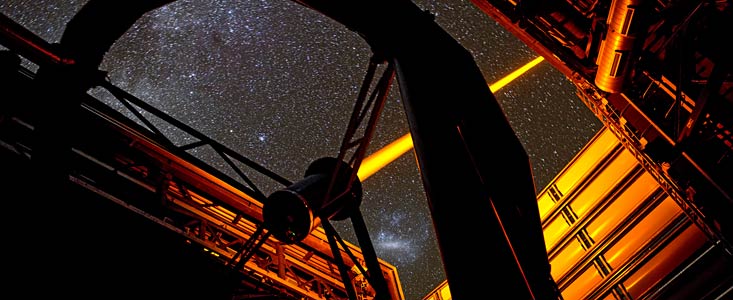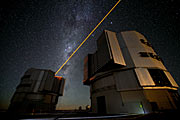Annuncio
New Laser Improves VLT’s Capabilities
21 Febbraio 2013
A new and more powerful laser has successfully completed testing at ESO’s Paranal Observatory and has been formally accepted today. This new laser source is called PARLA and forms a vital part of the Laser Guide Star Facility (LGSF) at ESO’s Very Large Telescope (VLT).
The laser is used to generate an artificial star about 90 kilometres up in the atmosphere [1]. By creating and observing such a bright point of light astronomers can probe the turbulence in the layers of the atmosphere above the telescope. This information is then used to adjust deformable mirrors in real time in order to correct most of the disturbances caused by the constant movement of atmosphere and create much sharper images.
The new laser will greatly improve the reliability and flexibility in operating the LGSF. It uses similar technology to that which will also be employed in the four lasers of the future Adaptive Optics Facility currently under development at ESO. The new laser delivers up to 7 Watts of output and is very stable.
During the commissioning and for demonstration purposes, some challenging targets were successfully observed using the new laser in conjunction with different VLT instruments. These included the dwarf planet Haumea and its moons and the peculiar radio galaxy Centaurus A.
This upgrade of the laser source takes advantage of a new solid-state Raman fibre laser technology currently under development at ESO, together with industrial partners, for the ESO Adaptive Optics Facility. It has already demonstrated greater reliability, which makes difficult observations possible more often. This facility will allow ESO to carry out challenging programmes that need laser guide stars every time the atmospheric conditions are suitable.
The original PARSEC dye laser used so far was close to the end of its lifetime after six years of service, during which it helped to make important new discoveries. The upgrade simplifies greatly the laser operation and gives astronomers more flexibility in planning their observations.
Notes
[1] An artificial star is created where the laser interacts with the 10-kilometre thick layer of neutral sodium atoms in the mesosphere causing them to fluoresce. Atomic sodium has an optical transition at a wavelength of 589 nanometres. The laser parameters are tuned to efficiently excite this atom.
Contatti
Steffan Lewis
ESO
Garching bei München, Germany
Tel: +49 89 3200 6931
Email: slewis@eso.org
Frederic Gonte
ESO, Paranal Observatory
Chile
Tel: +56 55 43 5248
Email: fgonte@eso.org
Richard Hook
ESO, Public Information Officer
Garching bei München, Germany
Tel: +49 89 3200 6655
Cell: +49 151 1537 3591
Email: rhook@eso.org
Riguardo all'annuncio
| Identificazione: | ann13010 |
Our use of Cookies
We use cookies that are essential for accessing our websites and using our services. We also use cookies to analyse, measure and improve our websites’ performance, to enable content sharing via social media and to display media content hosted on third-party platforms.
ESO Cookies Policy
The European Organisation for Astronomical Research in the Southern Hemisphere (ESO) is the pre-eminent intergovernmental science and technology organisation in astronomy. It carries out an ambitious programme focused on the design, construction and operation of powerful ground-based observing facilities for astronomy.
This Cookies Policy is intended to provide clarity by outlining the cookies used on the ESO public websites, their functions, the options you have for controlling them, and the ways you can contact us for additional details.
What are cookies?
Cookies are small pieces of data stored on your device by websites you visit. They serve various purposes, such as remembering login credentials and preferences and enhance your browsing experience.
Categories of cookies we use
Essential cookies (always active): These cookies are strictly necessary for the proper functioning of our website. Without these cookies, the website cannot operate correctly, and certain services, such as logging in or accessing secure areas, may not be available; because they are essential for the website’s operation, they cannot be disabled.
Functional Cookies: These cookies enhance your browsing experience by enabling additional features and personalization, such as remembering your preferences and settings. While not strictly necessary for the website to function, they improve usability and convenience; these cookies are only placed if you provide your consent.
Analytics cookies: These cookies collect information about how visitors interact with our website, such as which pages are visited most often and how users navigate the site. This data helps us improve website performance, optimize content, and enhance the user experience; these cookies are only placed if you provide your consent. We use the following analytics cookies.
Matomo Cookies:
This website uses Matomo (formerly Piwik), an open source software which enables the statistical analysis of website visits. Matomo uses cookies (text files) which are saved on your computer and which allow us to analyze how you use our website. The website user information generated by the cookies will only be saved on the servers of our IT Department. We use this information to analyze www.eso.org visits and to prepare reports on website activities. These data will not be disclosed to third parties.
On behalf of ESO, Matomo will use this information for the purpose of evaluating your use of the website, compiling reports on website activity and providing other services relating to website activity and internet usage.
Matomo cookies settings:
Additional Third-party cookies on ESO websites: some of our pages display content from external providers, e.g. YouTube.
Such third-party services are outside of ESO control and may, at any time, change their terms of service, use of cookies, etc.
YouTube: Some videos on the ESO website are embedded from ESO’s official YouTube channel. We have enabled YouTube’s privacy-enhanced mode, meaning that no cookies are set unless the user actively clicks on the video to play it. Additionally, in this mode, YouTube does not store any personally identifiable cookie data for embedded video playbacks. For more details, please refer to YouTube’s embedding videos information page.
Cookies can also be classified based on the following elements.
Regarding the domain, there are:
- First-party cookies, set by the website you are currently visiting. They are stored by the same domain that you are browsing and are used to enhance your experience on that site;
- Third-party cookies, set by a domain other than the one you are currently visiting.
As for their duration, cookies can be:
- Browser-session cookies, which are deleted when the user closes the browser;
- Stored cookies, which stay on the user's device for a predetermined period of time.
How to manage cookies
Cookie settings: You can modify your cookie choices for the ESO webpages at any time by clicking on the link Cookie settings at the bottom of any page.
In your browser: If you wish to delete cookies or instruct your browser to delete or block cookies by default, please visit the help pages of your browser:
Please be aware that if you delete or decline cookies, certain functionalities of our website may be not be available and your browsing experience may be affected.
You can set most browsers to prevent any cookies being placed on your device, but you may then have to manually adjust some preferences every time you visit a site/page. And some services and functionalities may not work properly at all (e.g. profile logging-in, shop check out).
Updates to the ESO Cookies Policy
The ESO Cookies Policy may be subject to future updates, which will be made available on this page.
Additional information
For any queries related to cookies, please contact: pdprATesoDOTorg.
As ESO public webpages are managed by our Department of Communication, your questions will be dealt with the support of the said Department.


